Mongolia lists five lake systems as Wetlands of International Importance

The Ramsar Secretariat is extremely pleased to announce that Mongolia has designated five new Wetlands of International Importance, covering nearly 809,000 ha, bringing the number of Ramsar  Wetlands in the country to 11. The nominations and Ramsar data sheets were prepared with the help of WWF Mongolia as part of a project co-funded by the Ramsar Small Grants Fund jointly with the WWF International 'Living Waters Programme'.
Wetlands in the country to 11. The nominations and Ramsar data sheets were prepared with the help of WWF Mongolia as part of a project co-funded by the Ramsar Small Grants Fund jointly with the WWF International 'Living Waters Programme'.
Mongolia, which joined the Convention on Wetlands in 1998, now has 11 Ramsar Sites covering a surface area of 1,439,530 hectares. Ms Liazzat Rabbiosi of the Ramsar Secretariat has prepared these brief site descriptions based on the Ramsar Information Sheets submitted by the Administrative Authority in Mongolia, the Department of International Cooperation, Ministry of Nature and Environment, from research by B. Ouyngerel and N. Tseveenmyadag of the Mongolian Academy of Sciences and Batnasan N., Freshwater Officer for the WWF Mongolia Programme Office.
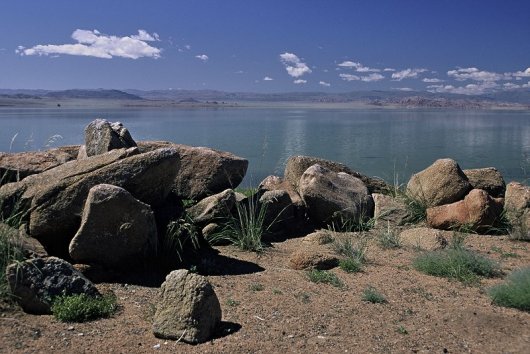
Lake Achit and its surrounding wetlands. 22/03/04; Bayan-Ulgii, Uvs Provinces; 73,730 ha; 49º40'N 090º35'E. Freshwater shallow lakes in the Khovd River basin in western Mongolia, with the Achit Lake being the largest in the Mongolian Altai range. The site, lying in an intermountain basin at 1435m, includes Devel State Nature Reserve to the south (1,030ha). Lakes are frozen from November to May. Important breeding and resting ground for a great variety of waterbirds, many listed in the Mongolian and IUCN Red Books, Red Data Book of Threatened Birds of Asia, CITES and CMS. The site supports more than 1% of the biogeographical population of Great Crested Grebe (Podiceps cristatus), Black Stork (Ciconia Nigra) and Ruddy Shelduck (Tadorna ferruginea), thus fulfilling Criterion 5. Several endemic fishes occur in the lakes. No human settlements lie in the vicinity; the surrounding land is normally used for nomadic stock farming or recreational purposes. The high potential for ecotourism has not been developed so far due to weak infrastructure and the remote location of the area. Ramsar site no. 1376. (Photo above: courtesy of WWF International/Anton Vorauer)
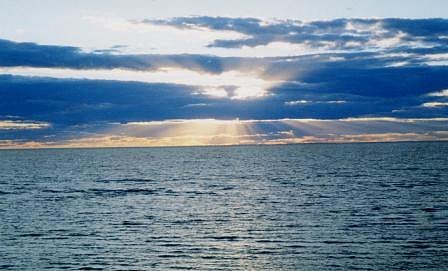
Lake Buir and its surrounding wetlands. 22/03/04; Dornod Province; 104,000 ha; 47°48'N 117°40'E. The largest freshwater lake in eastern Mongolia, part of the basin of the large Amur river, together with many associated small lakes - northeastern parts of the system outside the Ramsar Site boundary lie across the border with China. This transitional habitat between Daguur and Stipa steppes features flora and fauna characteristic of arid steppe; it regulates the Khalk gol River and the Buir lake's water regime and protects the origins of many small rivers, lakes, streams, and springs. The site is a main grazing land for the Mongolian gazelle (Procapra gutturosa), a stop-over and permanent ground for more than 236 bird species. Many fauna and flora species listed by IUCN, CITES, and CMS are present, making it very important for biogeographical biodiversity. No human settlements are found within the wetland apart from a small fishing village on the eastern coast to support the long established fishing industry on the lake. Extensive grazing has resulted in land degradation, but there is no other agricultural activity. Global warming has affected the water level, with consequent fish stock depletion. Ramsar site no. 1377. (Photo above: Tsogtsaikhan P.)
Lake Ganga and its surrounding wetlands. 22/03/04; Sukhbaatar Province; 3,280 ha; 45º15'N 114º00'E. Natural Monument Area. A small brackish lake (220ha) and associated lakes in eastern Mongolia within a unique landscape combining wetlands, steppe and sand dunes, located in the strip between the south steppe and Gobi zones. This lake district is based in the wind-scoured lowlands of extinct volcanoes and known as Dariganga. It is of great importance for breeding and stop-over waterbirds, e.g., White-naped Crane (Grus vipio), Swan Goose (Anser cygnoides), and Great Bustard (Otis tarda), all vulnerable or endangered in the the IUCN Red Book. Local people involved in nomadic and animal husbandry. A management plan for the Ganga Lake Monument Area is being elaborated with the objective of developing ecotourism in view of the great cultural (stone monuments) and natural ('swan assembly' in autumn) potential of the area. Ramsar site no. 1378.
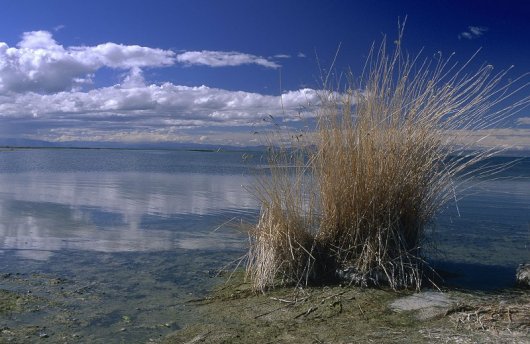
Lake Uvs and its surrounding wetlands. 22/03/04; Uvs Province; 585,000 ha; 50°20'N 092°45'E. UNESCO Biosphere Reserve. The largest saline lake in Mongolia with a small part lying in Russia, a unique wetland in desert-steppe landscape fringed by high mountain ranges; it has a maximum depth of 20m and freezes over from November to May. With reedbeds and river deltas it provides significant nesting and resting areas for 215 migratory waterbird species such as White-headed Duck (Oxyura leucocephala), Swan Goose (Anser cygnoides), both 'endangered' in the Red List of IUCN, and many other nationally and globally threatened flora and fauna species including endemic fish Oreoleuciscus potanini, Oreoleuciscus pewzowi, Oreoleuciscus humilis, are supported. Some nomadic families live along the shorelines using wetlands as pasture and watering points. A joint transboundary protected area is planned in cooperation with Russian authorities. The potential exists for recreation and birdwatching and a management plan is in preparation. Ramsar site no. 1379. (Photo above: courtesy of WWF International/Anton Vorauer)
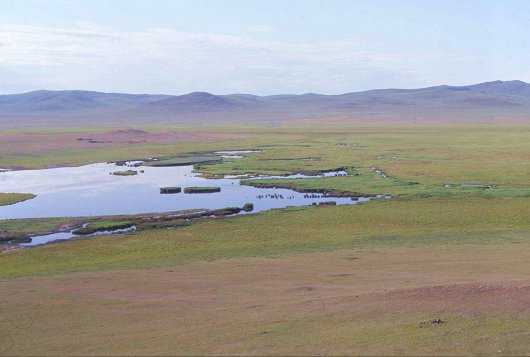
Lakes in the Khurkh-Khuiten river valley. 22/03/04; Khentii Province; 42,940 ha; 48°18'N 110°34'E. Permanent lakes located in the transition zone between Mongolian forest and steppe zones in the basin of the Khurkh-Khuiten river, a tributary to the great Onon River. The site is the habitat of many threatened and endangered species from the southern taiga, Central Asian steppe, and forest steppe of Daguur-Manjuria. In terms of Criterion 6, it supports 11% of the biogeographical population of White-naped Crane (Grus vipio), 3% Eurasian Crane (Grus Grus), 1% Demoiselle Crane (Anthropoides virgo), 15% Black Stork (Ciconia nigra). The main land use is for animal husbandry. Global warming has had implications for the reduction of the lakes' size. There is a potential for ecotourism, but currently no conservation measures have been taken. Ramsar site no. 1380. (Photo above: Tseveenmyadag, N., Mongolian Academy of Science).
A few additional photos
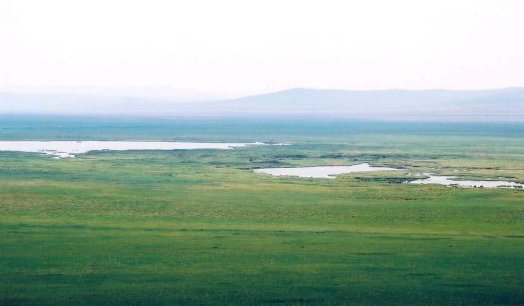
Lakes in the Khurkh-Khuiten valley (Tseveenmyadag, N., Mongolian Academy of Science).
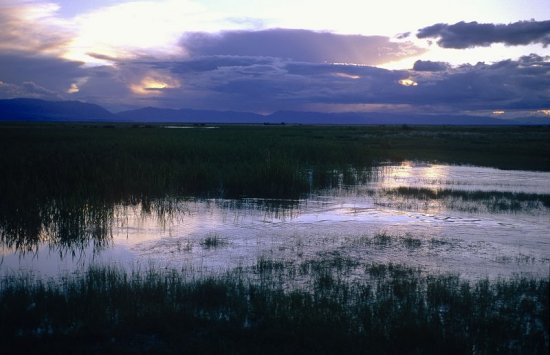
Lake Uvs (courtesy of WWF International/Anton Vorauer)
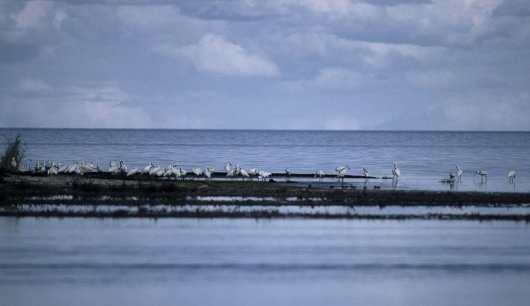
Spoonbills, Lake Uvs (courtesy of WWF International/Anton Vorauer)